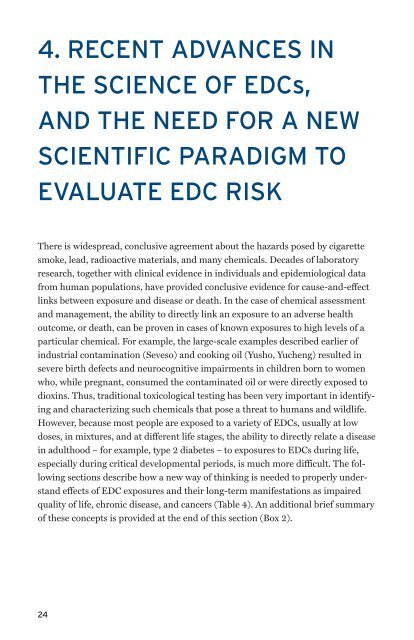Introduction to Endocrine Disrupting Chemicals
Introduction to Endocrine Disrupting Chemicals
Introduction to Endocrine Disrupting Chemicals
Create successful ePaper yourself
Turn your PDF publications into a flip-book with our unique Google optimized e-Paper software.
4. RECENT ADVANCES IN<br />
THE SCIENCE OF EDCs,<br />
AND THE NEED FOR A NEW<br />
SCIENTIFIC PARADIGM TO<br />
EVALUATE EDC RISK<br />
There is widespread, conclusive agreement about the hazards posed by cigarette<br />
smoke, lead, radioactive materials, and many chemicals. Decades of labora<strong>to</strong>ry<br />
research, <strong>to</strong>gether with clinical evidence in individuals and epidemiological data<br />
from human populations, have provided conclusive evidence for cause-and-effect<br />
links between exposure and disease or death. In the case of chemical assessment<br />
and management, the ability <strong>to</strong> directly link an exposure <strong>to</strong> an adverse health<br />
outcome, or death, can be proven in cases of known exposures <strong>to</strong> high levels of a<br />
particular chemical. For example, the large-scale examples described earlier of<br />
industrial contamination (Seveso) and cooking oil (Yusho, Yucheng) resulted in<br />
severe birth defects and neurocognitive impairments in children born <strong>to</strong> women<br />
who, while pregnant, consumed the contaminated oil or were directly exposed <strong>to</strong><br />
dioxins. Thus, traditional <strong>to</strong>xicological testing has been very important in identifying<br />
and characterizing such chemicals that pose a threat <strong>to</strong> humans and wildlife.<br />
However, because most people are exposed <strong>to</strong> a variety of EDCs, usually at low<br />
doses, in mixtures, and at different life stages, the ability <strong>to</strong> directly relate a disease<br />
in adulthood – for example, type 2 diabetes – <strong>to</strong> exposures <strong>to</strong> EDCs during life,<br />
especially during critical developmental periods, is much more difficult. The following<br />
sections describe how a new way of thinking is needed <strong>to</strong> properly understand<br />
effects of EDC exposures and their long-term manifestations as impaired<br />
quality of life, chronic disease, and cancers (Table 4). An additional brief summary<br />
of these concepts is provided at the end of this section (Box 2).<br />
24















